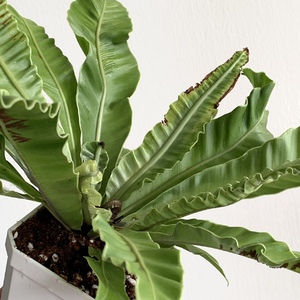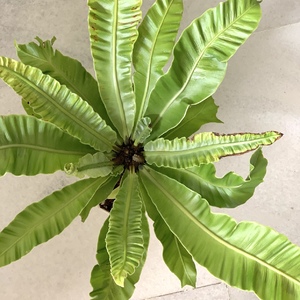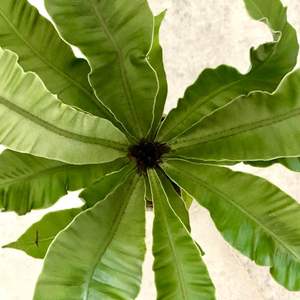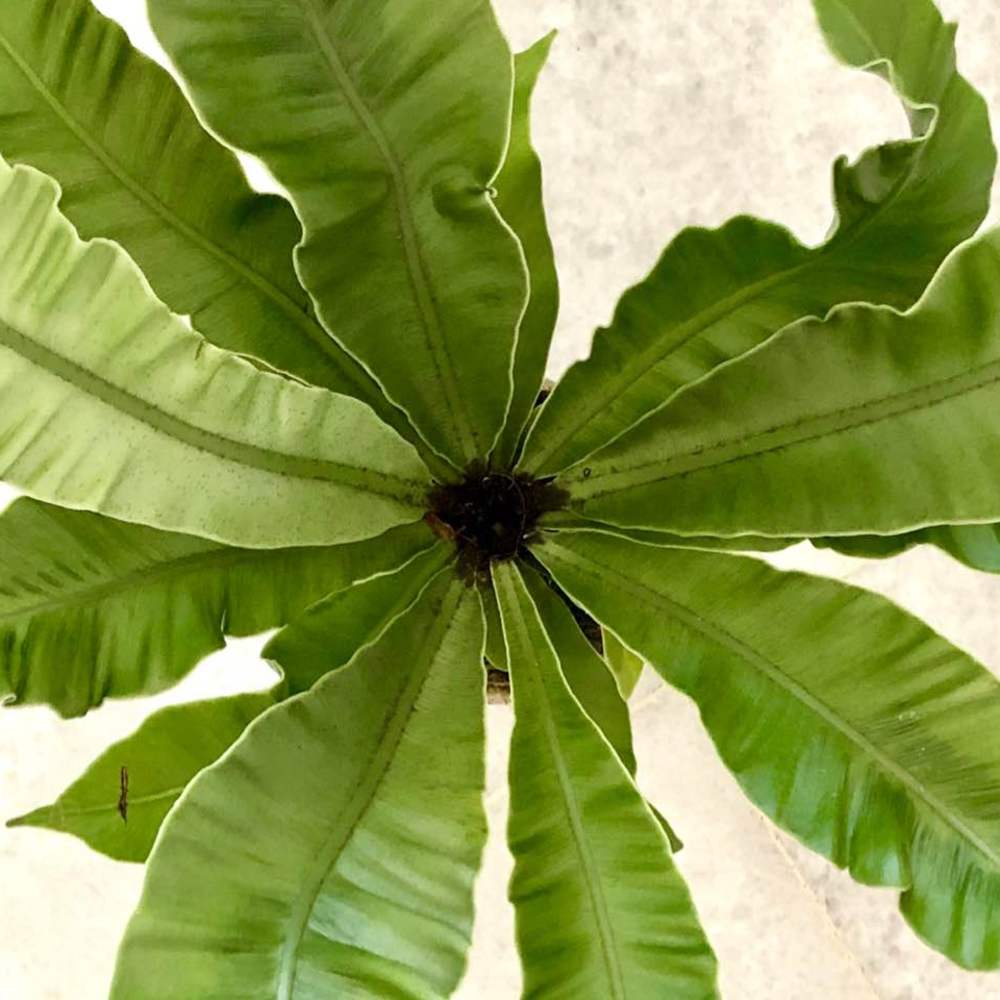植物经验
详细说明
A new cultivar that has very hard wavy fronds in gray-green color and white edge. Matures to approx. 50-60 cm. in diameter, but has low growth habit. Typically asplenium nidus grows well under bright shade with air movement. It requires airy compost and allow it getting fairly dry between watering.
To care for Asplenium nidus houseplants, place in an area of the home with indirect or shady light. Asplenium nidus prefer evenly moist surroundings. Watering the soil often during growth and housing the plant in a moderately humid area will help to maintain a healthy environment during care for Bird's Nest Fern.
Caring for Bird's Nest Fern
Avoid watering the center of the plant (the rosette) because it acts as a cradle and can cause the plant to rot. Instead, water the soil around the perimeter of the plant.
Test the moisture level by sticking a finger an inch into the soil. It should be damp, but not soggy. If dry, add about an inch of water.
Give the plant plenty of humidity by occasionally misting the fronds with a water bottle.
Add a layer of mulch over the soil surface to help it retain moisture.
During growing season, feed the fern every other week with a water-soluble fertilizer. Repot every couple of years in a larger pot with new soil.
However, providing some direct sunlight is great for the Bird's nest fern to grow well, but you need to only provide some morning or a small amount of pre-sunset. The fronds can become pale or have scorch marks on them if the sun is too hot.
Birds Nest Fern Care
Temperature:
Room temperatures between 65-75ºF (18-24ºC) are ideal, and no lower than 55ºF (13ºC).
Light:
Most books and guides will agree that bright light without direct sunlight should be provided. However, providing some direct sunlight is great for the Bird's nest fern to grow well, but you need to only provide some morning or a small amount of pre-sunset. The fronds can become pale or have scorch marks on them if the sun is too hot. During the winter the sun is much less harmful to the plant.
Watering:
This is a species that loves it's soil to remain moist at all times, but not soggy. Water around the edge of the center rosette to avoid the water becoming stagnant in the center, which may cause rot.
Soil:
A peat based potting mix is required. 2 parts peat and 1 part perlite (maybe a little less) is one mixture that will be fine. A peat based mixture with organic material is also good.
Fertilizer:
From April - September feed the plant with a weak diluted fertilizer every 2 weeks to encourage new growth and healthy looking leaves.
Re-Potting:
The Asplenium nidus does not need a pot change very often because it's roots are very small. Once every 2 years is advised for a mature species and once a year while it's young. These do not generally have a problem with becoming root bound, but have more of an issue with staying stable in the pot - this is because the roots are small and they're usually attached to a tree making their own mount. Watch out to see if the plant is becoming unstable and move to a larger pot if it is.
Humidity:
Humidity may need to be improved if it becomes low and the plant is showing signs of being affected by dry air. You can improve the humidity by standing the plant in a humidity tray, a tray of peat moss or use an electronic humidifier.
Propagation:
These are propagated by spore sowing which is very difficult for the average indoor grower to carry out. Many ferns can be propagated by division, not this species though.
To care for Asplenium nidus houseplants, place in an area of the home with indirect or shady light. Asplenium nidus prefer evenly moist surroundings. Watering the soil often during growth and housing the plant in a moderately humid area will help to maintain a healthy environment during care for Bird's Nest Fern.
Caring for Bird's Nest Fern
Avoid watering the center of the plant (the rosette) because it acts as a cradle and can cause the plant to rot. Instead, water the soil around the perimeter of the plant.
Test the moisture level by sticking a finger an inch into the soil. It should be damp, but not soggy. If dry, add about an inch of water.
Give the plant plenty of humidity by occasionally misting the fronds with a water bottle.
Add a layer of mulch over the soil surface to help it retain moisture.
During growing season, feed the fern every other week with a water-soluble fertilizer. Repot every couple of years in a larger pot with new soil.
However, providing some direct sunlight is great for the Bird's nest fern to grow well, but you need to only provide some morning or a small amount of pre-sunset. The fronds can become pale or have scorch marks on them if the sun is too hot.
Birds Nest Fern Care
Temperature:
Room temperatures between 65-75ºF (18-24ºC) are ideal, and no lower than 55ºF (13ºC).
Light:
Most books and guides will agree that bright light without direct sunlight should be provided. However, providing some direct sunlight is great for the Bird's nest fern to grow well, but you need to only provide some morning or a small amount of pre-sunset. The fronds can become pale or have scorch marks on them if the sun is too hot. During the winter the sun is much less harmful to the plant.
Watering:
This is a species that loves it's soil to remain moist at all times, but not soggy. Water around the edge of the center rosette to avoid the water becoming stagnant in the center, which may cause rot.
Soil:
A peat based potting mix is required. 2 parts peat and 1 part perlite (maybe a little less) is one mixture that will be fine. A peat based mixture with organic material is also good.
Fertilizer:
From April - September feed the plant with a weak diluted fertilizer every 2 weeks to encourage new growth and healthy looking leaves.
Re-Potting:
The Asplenium nidus does not need a pot change very often because it's roots are very small. Once every 2 years is advised for a mature species and once a year while it's young. These do not generally have a problem with becoming root bound, but have more of an issue with staying stable in the pot - this is because the roots are small and they're usually attached to a tree making their own mount. Watch out to see if the plant is becoming unstable and move to a larger pot if it is.
Humidity:
Humidity may need to be improved if it becomes low and the plant is showing signs of being affected by dry air. You can improve the humidity by standing the plant in a humidity tray, a tray of peat moss or use an electronic humidifier.
Propagation:
These are propagated by spore sowing which is very difficult for the average indoor grower to carry out. Many ferns can be propagated by division, not this species though.
花相册 (3)



kensong
2019年01月05日

Finally repotted.




kensong
2018年08月31日

This is my first growing diary.







